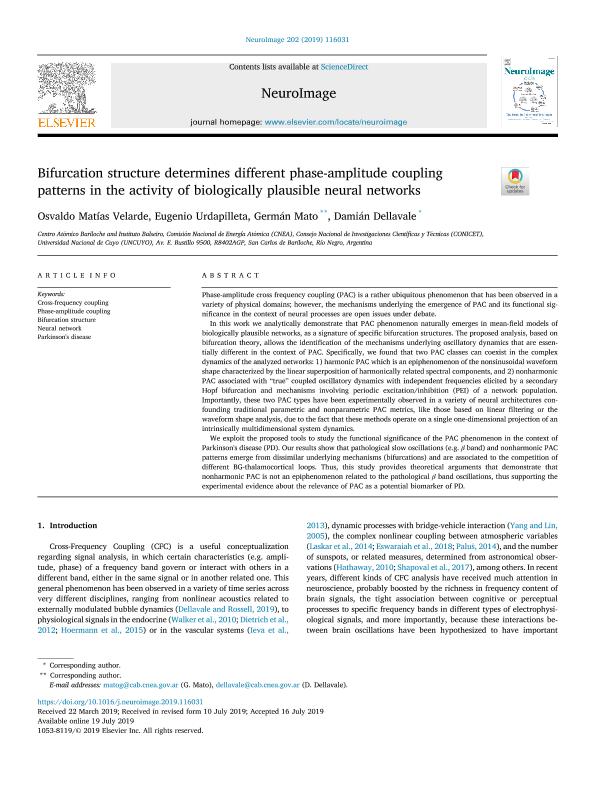Artículo
Bifurcation structure determines different phase-amplitude coupling patterns in the activity of biologically plausible neural networks
Fecha de publicación:
15/11/2019
Editorial:
Academic Press Inc Elsevier Science
Revista:
Journal Neuroimag
ISSN:
1053-8119
Idioma:
Inglés
Tipo de recurso:
Artículo publicado
Clasificación temática:
Resumen
Phase-amplitude cross frequency coupling (PAC) is a rather ubiquitous phenomenon that has been observed in a variety of physical domains; however, the mechanisms underlying the emergence of PAC and its functional significance in the context of neural processes are open issues under debate. In this work we analytically demonstrate that PAC phenomenon naturally emerges in mean-field models of biologically plausible networks, as a signature of specific bifurcation structures. The proposed analysis, based on bifurcation theory, allows the identification of the mechanisms underlying oscillatory dynamics that are essentially different in the context of PAC. Specifically, we found that two PAC classes can coexist in the complex dynamics of the analyzed networks: 1) harmonic PAC which is an epiphenomenon of the nonsinusoidal waveform shape characterized by the linear superposition of harmonically related spectral components, and 2) nonharmonic PAC associated with “true” coupled oscillatory dynamics with independent frequencies elicited by a secondary Hopf bifurcation and mechanisms involving periodic excitation/inhibition (PEI) of a network population. Importantly, these two PAC types have been experimentally observed in a variety of neural architectures confounding traditional parametric and nonparametric PAC metrics, like those based on linear filtering or the waveform shape analysis, due to the fact that these methods operate on a single one-dimensional projection of an intrinsically multidimensional system dynamics. We exploit the proposed tools to study the functional significance of the PAC phenomenon in the context of Parkinson's disease (PD). Our results show that pathological slow oscillations (e.g. β band) and nonharmonic PAC patterns emerge from dissimilar underlying mechanisms (bifurcations) and are associated to the competition of different BG-thalamocortical loops. Thus, this study provides theoretical arguments that demonstrate that nonharmonic PAC is not an epiphenomenon related to the pathological β band oscillations, thus supporting the experimental evidence about the relevance of PAC as a potential biomarker of PD.
Archivos asociados
Licencia
Identificadores
Colecciones
Articulos(CCT - PATAGONIA NORTE)
Articulos de CTRO.CIENTIFICO TECNOL.CONICET - PATAGONIA NORTE
Articulos de CTRO.CIENTIFICO TECNOL.CONICET - PATAGONIA NORTE
Citación
Velarde, Osvaldo Matias; Urdapilleta, Eugenio; Mato, German; Dellavale Clara, Hector Damian; Bifurcation structure determines different phase-amplitude coupling patterns in the activity of biologically plausible neural networks; Academic Press Inc Elsevier Science; Journal Neuroimag; 202; 116031; 15-11-2019; 1-20
Compartir
Altmétricas




